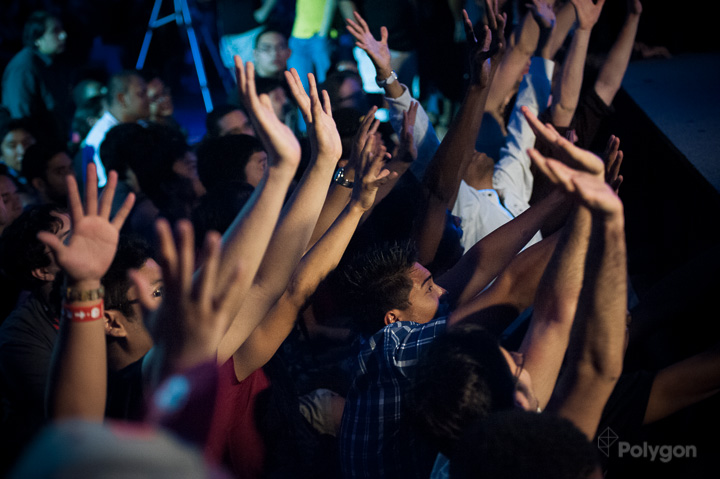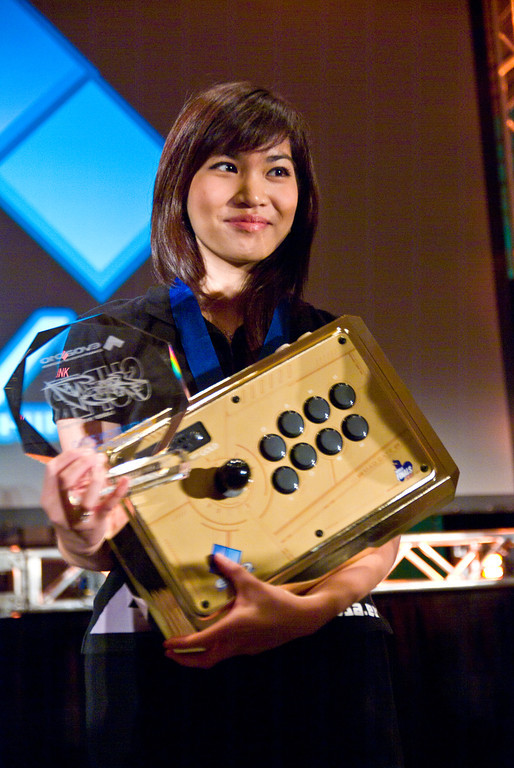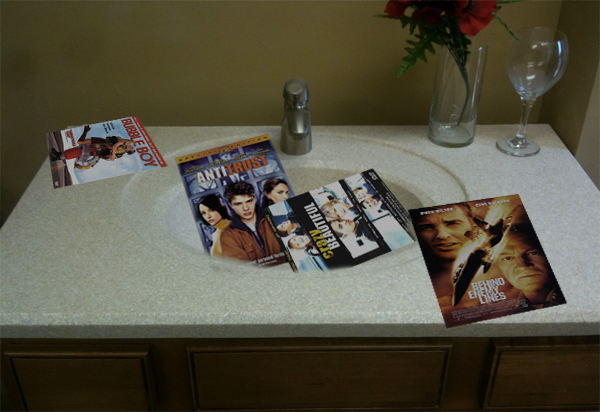By Mitch Bowman on February 06, 2014 at 12:01p
How the FGC's roots grew the most racially diverse community in gaming.
Tom Cannon is a StarCraft player. He is also black. And in the hypercompetitive eSports scene, those two things just don't go well together.
Getting into competitive gaming isn't easy for anyone. Most professional gamers play their game of choice as a full-time job and put an incredible number of hours into mastering their craft. In many cases, the types of games they play — StarCraft 2, League of Legends, etc. — aren't even easy to begin. They have steep learning curves, with huge bodies of required knowledge and existing players that have been learning and improving for years.
For Cannon, there was one more barrier to entry.
"When you look at the crowd ... it's literally like ... find the black person. It's all Korean people from Korea, or Asian-Americans, or Caucasians — almost 100%," says Cannon. "And it's a little bit intimidating to think OK, I'm going to go in here, and like, be a part of this thing, when there's nobody who looks like me in this scene."
A look through the rosters of North America's professional StarCraft teams confirms Cannon's story. He usually is the only black person in the room at the tournaments.
This lack of diversity is not uncommon in eSports. In North America, the League of Legends professional scene is completely dominated by Asian-Americans and Caucasians, and you'd be hard-pressed to find a black or Latino face in the ranks of the teams present at League of Legends' North American Regionals.
Clearly, eSports in general has a diversity problem, and it's hard to pinpoint exactly what the cause of it is. One answer might be found by looking at a very different kind of competitive gaming — one that, seemingly against all logic, seems to have cracked the problem of racial diversity.

Open to everyone
Open to everyone
The fighting game community, or FGC, is a strange entity. These days, it primarily consists of an international network of tournaments, from tiny local competitions with only a dozen or fewer attendees, right up to EVO, an annual Las Vegas event which drew more than 3,500 competitors in 2013. These tournaments take place in a wide variety of locales, from hotel convention halls, to the rare surviving arcades, to the living rooms of community members. Elsewhere in the world, particularly in East Asia, similar events can be found in LAN cafés and huge, multistory game centers.
Within the FGC, the atmosphere in many ways is completely at odds with other competitive gaming communities. Some distinctions are unobtrusive; players can actually hear the crowd react to big plays, for example. In other ways, though, the differences have an enormous impact on the way one feels when entering the community for the first time.
Reminiscing about his time spent at EVO, an event that is largely considered the biggest fighting game tournament in the world, professional fighting game player Alex Valle says, "EVO's tournaments are designed for the masses to play, regardless of race, gender, religious beliefs, any of that stuff, because [they're] designed to find who the best players are in the world.
"And that's a really powerful message, in my opinion, because the fighting game community is one of the only communities out there where you're playing next to somebody — right there. There's no booths, there's nobody playing on the other side of the country or whatever. You're playing right next to each other. You get to see, and kind of feel the aura of the person you're playing against. That's really powerful stuff."

Fighting game tournaments will let anyone who wants to play, play. Unlike the league-based structure of most professional gaming tournaments, fighting game competitions are open to all. Everyone gets lumped together in the same pool, too — someone could show up to their very first tournament and get matched against the reigning world champion in their first match of the day.
Valle isn't alone in his belief that this face-to-face competition helps draw the community together. Cannon, who happens to be one of the three people who started EVO back in 2002, has similar thoughts.
"The thing that has carried over the most [from arcades to the current FGC], and it was probably the most important thing about the arcade, is that it was face-to-face," Cannon says. "And of course that's carried over, because no one's figured out how to make online fighting games really competitive because of the latency. I mean they're good, they're a lot better than they used to be, but [they're] still not up to the standards where you can really play a serious game at the highest level of competitive play. Not in the same way that you can in StarCraft, or even FPS games.
"So if you want a serious competition, it's still face-to-face, fighting it out. And it's really interesting how that changes the dynamic, because you can't hide behind a keyboard. It's not like the really nasty stuff you see on ... famously I guess on Xbox Live, where, you know, you're a little bit different in whatever way and people will just mock you over chat because they can — people won't do that to your face."

On top of preventing much of the nastiness one often finds in online gaming communities, and in turn providing a much more welcoming environment for people who may have been marginalized by other areas of society, the real-world, in-person nature of fighting game competition has also allowed a tight-knit community to form.
"I would say like 80 percent of my friends are from CEO and gaming now," says Alex Jebailey, who runs another large American fighting game tournament called CEO. "I use CEO as my hobby to just bring people together; that's my ultimate goal. If I can make a little money to keep putting on the event, I'm happy, as long as I don't go broke doing it. At the end of the day, I think of all the connections I've helped make. People have gotten jobs because of meeting other people at my event, relationships have formed. It just brings everyone together."
Jebailey is also a regular EVO attendee.
"You go to EVO and they have like, over 30 countries represented, and pretty much every state in the U.S., all over the place," he says. "It's everyone's hobby, and they know they can get away and keep doing what they love, and no one's going to judge them when they're among people that do the same thing."
And if all of this makes it sound like the FGC, at its various events, is radically more welcoming and diverse than its eSports cousins, that's because it is. And the roots of the FGC's inclusion come from its beginnings, in the arcade.
To figure out how the FGC ended up so different from other competitive gaming communities, it's necessary to look deeper into the history of fighting games, beyond the current state of the FGC tournament circuit. That means taking a look at the place where it all started for fighting games: the arcade.
Legacy of the arcade
Legacy of the arcade
It used to be easy to find an arcade machine in the average North American city. Arcades were on every university campus, in every shopping mall and strewn along the major streets of most downtown cores. Even if you lived in the suburbs, you could find arcade machines at your local pizza place, bowling alley or ice skating rink.
For most of the 1990s, a ton of the games you'd find in the average arcade belonged to the same genre: fighting. Whether it was a Mortal Kombat cabinet or a Street Fighter 2 machine, or one of the countless other games inspired by the success of the aforementioned duo, it was almost impossible not to stumble across a fighting game.
An entire generation of young adults was raised by the likes of Ken and Ryu. For many of these gamers, arcades were more than a place to enjoy a simple hobby — they were a safe haven, somewhere they could go and do something they loved, without being judged or ridiculed for their passions.
Not that it was always the friendliest place, necessarily. In 2011, David Philip Graham (aka UltraDavid), wrote extensively about the old-school arcade scene, and described his experience thusly:
"If you lost, you walked away without any acknowledgement from the champion, got back to the end of a huge line, and had long enough to wait until your next game to stew on your loss and really start to hate the guy who beat you. Maybe he was the best player in your arcade or maybe the best player in the country, but you could stand right next to him and talk with him when he was off the machine. Of course, you could only talk if you had respect, and you only got respect if you won."
Despite this, he noted that conflict was rarely brought on by differences in background, and everyone competed on a level playing field. "It was personal and confrontational and insular, but you'd respect anyone who won regardless of race or sexual orientation," Graham concluded.
Most of the veterans of the FGC have their own stories about their local arcades.
"When I went to these places — and not just arcades, but pool halls and any kind of recreational meetup — it was a place to go," says Alex Valle. "These places, especially the arcades, you can be playing a game, and it did not matter, boy or girl, black, white, Asian, Latino, you're playing with another person and that stuff doesn't even matter. You care more about the game than about the person you're playing with — until you see what the other person's capable of.
"They found out that I lived nearby, that I was good at the game and all that [race] stuff didn't even matter anymore."
"Back then, there was a lot of discrimination and stereotypes and stuff [in everyday life], but that goes away as soon as you start appreciating each other's skill, or whatever friendships you make off of these games. That's the time I grew up in, going to these arcades, and meeting these crazy, phenomenal, funny, angry, happy people that I have lifelong friendships with today."
This is a common refrain among people who grew up spending a lot of their time at their local arcades. In seemingly every local community, the atmosphere was one of inclusiveness that was sometimes at odds with the outside world.
"I'm Peruvian, from South America, and one of the first arcades I used to play at was a place called Mission Control in ... Westminster, Calif.," Valle says. "Westminster is also known as Little Saigon, the Vietnamese business district. It's the highest-populated Vietnamese community in the United States. Westminster was right next to a city called Santa Ana, which has a really high Latino population, but I lived [and still live] in Westminster.
Valle's game at Mission Control was Street Fighter 2. His go-to character: Ken.
"The community in there, they always called me 'the MexiKen,'" Valle says. "They thought I was Mexican. So for the longest time they kept calling me that, and you know, I thought it was annoying at first. Because back when you're young, you're like 'No man, I'm Peruvian!,' but at that time, I was outnumbered, so I couldn't really do much. Eventually I started using other characters though, and they saw that I was a regular, and then they got to know my name, and everything was cherry from there."
The early '90s were a time of high crime and gang activity in Valle's neighborhood in the south of Los Angeles. Walking into an all-Asian neighborhood as a Latino could have been a problem for him. Yet he bridged the racial divide through games.
"They opened their doors to me; they found out that I lived nearby, that I was good at the game and all that [race] stuff didn't even matter anymore," he says. "I think that's a really big deal ... it doesn't matter what your background is; if we share the same passion for the game, we're gonna enjoy it together."
Far from being an exception to the rule, Valle's story reflects that of many of his contemporaries. Jebailey, who was a competitive player for a long time before he started organizing CEO, has a similar story about his earliest memories of his local fighting game scene.
Jebailey's mother would drop him off at the local ice skating rink, Rock On Ice, every weekend, where he would play Mortal Kombat and Street Fighter 2 with neighborhood kids of all races.
"Race wasn't really ever an issue there," Jebailey says. "Back in the day we had that place, and we had Malibu Grand Prix. That was where I grew up; that was the main arcade I used to play at. I would go all the time; that was my big hobby. I would finish my schoolwork, and then on weekends my parents would just drop me off ... and nobody really cared [about race]. People just wanted to play games.
The state of California, where both Valle and Jebailey grew up, is far from the only place that fostered this kind of environment. Justin Wong, one of the most dominant fighting game professionals the U.S. has ever produced, grew up in New York City. His experiences closely resemble those of his California colleagues.
"I grew up at Chinatown Fair in the '90s," Wong says. I was just born as an arcade kid. ... [Chinatown Fair] is located in Chinatown, and obviously it was affiliated with a lot more Asian people than other ethnicities. But eventually, the arcade actually grew to the point where everyone, doesn't matter what ethnicity you were, just went to the arcade. It was actually a safe place, even though a lot of parents — even my parents — were saying 'Don't go to that place; it's very bad; there's a lot of bad people there.' It was like a family there, even if I didn't know the person's name but I'd seen them at the arcade, we'd just nod our heads and say 'Hey what's up. Enjoy your games today.'"

Characters like me
Characters like me
There are a lot of factors that led to the arcade scene's diversity. Foremost among them: Fighting games were cheap when they first arrived in arcades, and in most places, they remained cheap for as long as the arcades existed. The barrier to entry was a mere 25 cents. In practice, this lower barrier of entry has opened the community up to people a lot farther down the socioeconomic ladder than the average StarCraft or League of Legends player, and that means a lot more members of marginalized minorities can get their foot in the door.
As fighting game player and game writer Pat Miller puts it, "You have this huge mix of people, this huge range of people, and I think that's because, you know, you didn't need to own a two or three thousand dollar computer to play games. You didn't even have to have a TV and a console. You could just play with a quarter when you were walking around town. ... When you have that space where anyone can go ahead and drop by, play a game, shoot the shit, whatever — and you actually have an incentive to go out to different places and start playing new people who you're not used to playing against — that really kind of did attract a diverse audience."
Miller, who is part Filipino, also has another idea about diversity in fighting games that hits much closer to home for him.
"Honestly, one of [the reasons for diversity in the FGC] I think is the representation of people of color in the games themselves," Miller says. "We'll joke about how crazy essentialist and stereotypical a lot of the characters are, but at the end of the day, I'm pretty sure there weren't that many Indian characters until Dhalsim, or Russian characters until Zangief, or Brazilian characters until Blanka. ... The first Filipino character [I ever saw] in a game was Talim from Soulcalibur 2. I was really stoked to see that ... I like having those points of identification; [that's] probably one of the things that made it much easier to bring people into the community. They see that and they think, 'These are all really fascinating characters. I kind of like this guy. I kind of identify with this guy. I'm gonna go play as him.'"
Miller has encountered other players who personally identify with the race of the character they play as, too. Years ago at an EVO tournament, he got paired against a Mexican opponent in the first round. His adversary was playing as El Fuerte, the Mexican luchador character from Street Fighter 4.
This inclusiveness within the games themselves sets fighting games at odds with the majority of popular eSports games. First-person shooters are almost always filled with identical Caucasian soldier types, and RTSs and MOBAs generally sport a variety of aliens and/or monsters, with a few hypersexualized white girls thrown in for good measure.
League of Legends, arguably the most popular competitive game in the world right now with a roster of 116 playable characters, didn't have a single black character until the introduction of Lucian a few months ago. He was character number 115 — and his alternate costume makes him look white.
The dark side
The dark side
 Marie-Laure "Kayane" Norindr (photo courtesy Kara Leung/EVO)
Marie-Laure "Kayane" Norindr (photo courtesy Kara Leung/EVO)
Of course, there's still room for improvement in the fighting game community. Even while doing impressive things in the realm of racial diversity, the FGC shares a burden with the rest of eSports when it comes to another diversity-related issue, one that plagues all of gaming.
If you attend any sizable fighting game tournament, you'll notice two things about the crowd almost immediately. The first is the presence of virtually every race under the sun. The second is the almost complete lack of women. The unfortunate result of this gender imbalance is a negative feedback loop; because there's not very many women in the FGC already, it's not easy for women to enter the FGC. In many ways, it's the same problem Cannon faced in the StarCraft community.
To make matters worse, the FGC has also had a bit of a rocky history with gender politics. Perhaps most prominent among the FGC's run-ins with gender issues is an incident that took place in early 2012. Capcom was in the middle of running a Twitch-streamed fighting game reality show called Cross Assault as part of its promotion for the upcoming release of Street Fighter X Tekken. During the show's fifth day of competition, Twitch community manager Jared Rea broached the subject of the often coarse language used during fighting game competition, and questioned whether such unwelcoming vernacular was something that should be part of the FGC. One competitor on the show, Aris Bakhtanians, replied that trash-talking (and particularly sexual harassment) was an integral part of the FGC.
"The sexual harassment is part of the culture," Bakhtanians claimed. "If you remove that from the fighting game community, it's not the fighting game community ... it doesn't make sense to have that attitude. These things have been established for years."
Bakhtanians' statements, combined with the general language used throughout the matches showcased during the Cross Assault competition, highlighted a problem with the FGC's general attitude toward women. As one would expect, the backlash against this series of events was sizable, and the whole affair led to Capcom apologizing for its role in the proceedings.
One of only two women who competed on Cross Assault, Miranda "Super Yan" Pakozdi, forfeited her next match in order to leave the show immediately after Bakhtanians' comments were streamed. The incident remains a black mark on the reputation of the FGC, and to some it is still indicative of the community's general attitude toward women.
As UltraDavid mentioned in his editorial, "The fighting game scene is the oldest competitive video gaming community, old enough to have its roots in an American culture that clung strongly to the view that video games were the exclusive domain of young men. Arcades weren't for girls, and they looked like it."
Inevitably, this has hampered the ability of women to enter and feel at home within the FGC. As it stands, there are only a handful of women who can be counted as serious competitive players; a generous estimate puts this number at around half a dozen.
One of the most well-known female fighting game competitors is French Soulcalibur and Street Fighter player Marie-Laure "Kayane" Norindr. She's been playing in fighting game tournaments for over a decade, and is a regular sight on the European tournament circuit. In the aftermath of 2012's Cross Assault debacle, she was interviewed by GameSpot about her experiences as a woman in the FGC.
"When I became a young woman around the time I was 16, people stopped criticizing me about my age and began criticizing my gender," says Kayane, who began playing competitively at a very young age. "Because I was in the media a lot during that time, many people said it was because I was a woman rather than the fact that I was good at these games."
It's easy to see how women can end up attracting this kind of negative attention in a community with such a small group of female players, and the most viable solution seems to be to increase the presence of women at the FGC's largest and most prominent events. Fortunately, as gaming continues to become an increasingly mainstream — and gender-agnostic — activity, it's possible that the FGC (and other eSports communities) will see an increase in their representation of women as well.
Feedback loop
Feedback loop
Despite its remaining shortcomings, there's likely a lesson to be learned from the FGC when it comes to making the wider eSports world a more inclusive place. Cannon, after over a decade of running the world's biggest fighting game tournament, has some thoughts on how other communities might be able to promote diversity in their ranks.
"I would put an emphasis on play, rather than spectating," Cannon says. "Top players are role models, and you want to increase that pool of role models, and as you increase it, I think you increase your odds of diversity. If you're always focusing only on the top 20 players in the world, and [as in StarCraft] 15 of them are Korean, then that's just never gonna happen. Fighting games don't have this dynamic like, 'Here are the top players; let's put them on a pedestal, and then here are the many, many fans who watch their every move.' That dynamic almost doesn't exist in fighting games. Everyone is a player, pretty much; there aren't that many pure fans, and it's because we put an emphasis on play, which goes back to arcades."
In fighting game tournaments, anyone can step up and play, and when they're not playing, they're standing by, watching and waiting. At most tournaments there's also an open playing area, where competitors who are waiting for their turn, or those who've already been knocked out can also play, learn and get to know one another. Cannon believes this not only opens up the events to a wider array of competitors, but opens the competitors to a wider pool of potential role models.
"It's not just the tip of the iceberg," Cannon says. "You have this whole hierarchy of players, and if you're a new player, you can look up to like, Justin Wong, but you can also look up to the local master in your area, who has no chance of beating Justin Wong, but can teach you the basics of the game. And because there are so many more of these guys, odds are that you will get a wider base of diversity. ... Once you have some set of diverse role models, you can start to get into a positive feedback loop and get into diversity that way."
Whether the rest of the eSports world will learn anything from the inclusiveness of the FGC remains to be seen. For now, the fighting game community remains a unique entity within the world of competitive gaming, in many different ways, but particularly in its ample representation of people from all walks of life.
There may well be room for improvement, but it remains — even now, long after the death of the arcade — a safe haven for people who struggle to find acceptance elsewhere, and a place to go for those seeking the thrill of competition with no technological buffer between participants. 























 “Mickey Mouse and the Submarine Pirates,” Charles “Teenie” Harris, 1947
“Mickey Mouse and the Submarine Pirates,” Charles “Teenie” Harris, 1947





























 Reuters
Reuters 



 Marie-Laure "Kayane" Norindr (photo courtesy Kara Leung/EVO)
Marie-Laure "Kayane" Norindr (photo courtesy Kara Leung/EVO)


















